
Admiral of the Fleet Richard Howe, 1st Earl Howe, was a British naval officer. After serving throughout the War of the Austrian Succession, he gained a reputation for his role in amphibious operations against the French coast as part of Britain's policy of naval descents during the Seven Years' War. He also took part, as a naval captain, in the decisive British naval victory at the Battle of Quiberon Bay in November 1759.

Admiral of the Fleet George Anson, 1st Baron Anson, was a Royal Navy officer. Anson served as a junior officer during the War of the Spanish Succession and then saw active service against Spain at the Battle of Cape Passaro during the War of the Quadruple Alliance. He then undertook a circumnavigation of the globe during the War of Jenkins' Ear. Anson commanded the fleet that defeated the French Admiral de la Jonquière at the First Battle of Cape Finisterre during the War of the Austrian Succession.

Admiral Augustus John Hervey, 3rd Earl of Bristol, PC was a Royal Navy officer and politician. He commanded the sixth-rate HMS Phoenix at the Battle of Minorca in May 1756 as well as the third-rate HMS Dragon at the Capture of Belle Île in June 1761, the Invasion of Martinique in January 1762 and the Battle of Havana in June 1762 during the Seven Years' War. He went on to be Chief Secretary for Ireland and then First Naval Lord. He was known as the English Casanova, due to his colourful personal life.
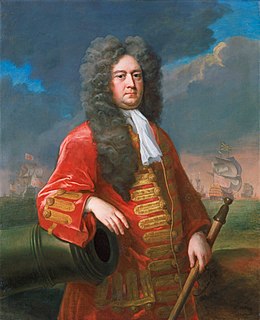
Admiral of the Fleet Sir George Rooke was an English naval officer. As a junior officer he saw action at the Battle of Solebay and again at the Battle of Schooneveld during the Third Anglo-Dutch War. As a captain, he conveyed Prince William of Orange to England and took part in the Battle of Bantry Bay during the Williamite War in Ireland.

Admiral of the Fleet Edward Russell, 1st Earl of Orford, PC was a Royal Navy officer and politician. After serving as a junior officer at the Battle of Solebay during the Third Anglo-Dutch War, he served as a captain in the Mediterranean in operations against the Barbary pirates.

Admiral Sir Charles Saunders was a Royal Navy officer. He commanded the fourth-rate HMS Gloucester and led her in action at the Second Battle of Cape Finisterre in October 1747 during the War of the Austrian Succession. After serving as Commander-in-Chief, Mediterranean Fleet, he was appointed Commander-in-Chief, English Channel in charge of the Western Squadron between October 1758 and May 1759). He took command of the fleet tasked with carrying James Wolfe to Quebec in January 1759 and consolidated the dead general's victory after the Battle of the Plains of Abraham in September 1759 by devoting great energy to keeping the British Army, now under the command of Colonel George Townshend, well supplied during the Seven Years' War. He later became Senior Naval Lord and then First Lord of the Admiralty.
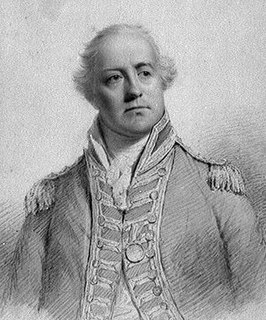
Admiral of the Fleet James Gambier, 1st Baron Gambier, was a Royal Navy officer. After seeing action at the capture of Charleston during the American Revolutionary War, he saw action again, as captain of the third-rate HMS Defence, at the battle of the Glorious First of June in 1794, during the French Revolutionary Wars, gaining the distinction of commanding the first ship to break through the enemy line.
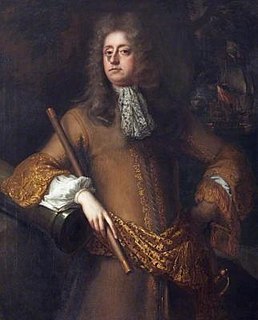
Admiral Arthur Herbert, 1st Earl of Torrington was an English admiral and politician. Dismissed by King James II in 1688 for refusing to vote to repeal the Test Act, which prevented Roman Catholics from holding public office, he brought the Invitation to William to the Prince of Orange at The Hague, disguised as a simple sailor. As a reward he was made commander of William's invasion fleet which landed at Torbay in Devon on 5 November 1688 thus initiating the Glorious Revolution.

Admiral of the Fleet Sir John Norris was a Royal Navy officer and Whig politician. After serving as a junior officer during the Nine Years' War and the Williamite War in Ireland, he was given command of a squadron sent to North America to protect British settlements on the banks of Hudson Bay in 1697. Although he developed a plan to recapture some territories in Newfoundland and Labrador taken by French forces the previous winter, he was prevented from implementing that plan when the local council overruled him.

Admiral of the Fleet Matthew Aylmer, 1st Baron Aylmer, of Covent Garden, Westminster, and Westcliffe, near Dover, was an Anglo-Irish Royal Navy officer and Whig politician who sat in the English and British House of Commons between 1695 and 1720.
Admiral Vere Beauclerk, 1st Baron Vere, known as Lord Vere Beauclerk until 1750, was a Royal Navy officer, British peer and politician who sat in the House of Commons for 24 years from 1726 to 1750. After serving various ships in the Mediterranean and then commanding the third-rate HMS Hampton Court, he joined the Board of Admiralty, ultimately serving as Senior Naval Lord.

Admiral of the Fleet Sir John Leake was a Royal Navy officer and politician. As a junior officer he saw action at the Battle of Texel during the Third Anglo-Dutch War. He then distinguished himself when he led the convoy that broke the barricading boom at Culmore Fort thereby lifting the siege of Derry during the Williamite War in Ireland. As a captain he saw action in some of the heaviest fighting at the Battle of Barfleur and was also involved in a successful attack on the French ships at the Battle of La Hogue during the Nine Years' War.
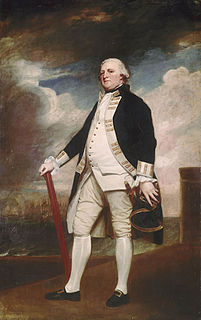
Vice Admiral George Darby was a Royal Navy officer. He commanded HMS Norwich at the capture of Martinique in 1762 during the Seven Years' War. He went on to command the Channel Fleet during the American Revolutionary War and later in that war served as First Naval Lord when he commanded the force that relieved Gibraltar from its siege by the Spanish in April 1781.

Lord Archibald Hamilton of Riccarton and Pardovan was a British officer of the Royal Navy, and Whig politician who sat in the House of Commons between 1708 and 1747. In the 1690s, he was active in the English Channel pursuing French privateers, including Tyger out of St Malo. He commanded the third-rate HMS Boyne at the Battle of Vigo Bay in October 1702 and then commanded the third-rate HMS Eagle at the Battle of Málaga in August 1704 during the War of the Spanish Succession. He was a controversial Governor of Jamaica. He then joined the Board of Admiralty, ultimately serving as Senior Naval Lord.
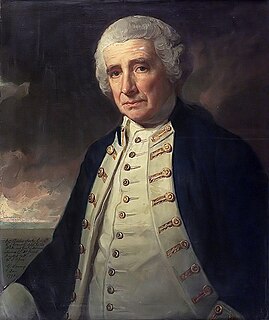
Admiral of the Fleet John Forbes, styled The Honourable from 1734, was a Royal Navy officer. After taking part in an expedition to Lisbon to support the Portuguese in the face of a Spanish threat, he saw action as captain of the third-rate HMS Norfolk at the Battle of Toulon during the War of the Austrian Succession. He was one of the few captains who really bore down on the enemy.

Admiral of the Fleet Sir Stafford Fairborne was a Royal Navy officer and Whig politician. As a captain he saw action in command of various ships at the Battle of Beachy Head, at the Battle of Barfleur and at the Battle of Lagos during the Nine Years' War.
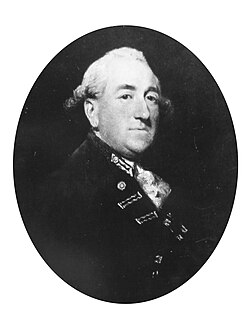
Rear-Admiral John Leveson-Gower was a Royal Navy officer and politician from the Leveson-Gower family. As a junior officer he saw action at the Battle of Lagos in August 1759 during the Seven Years' War. As captain of HMS Valiant he was present at the Battle of Ushant on 17 July 1778 during the American War of Independence. He went on to be a junior Lord of the Admiralty and then First Naval Lord. He also sat as Member of Parliament for several constituencies.

Admiral John Markham, was a Royal Navy officer. As a junior officer he served in the American Revolutionary War. He commanded the third-rate HMS Hannibal in the action of 10 April 1795 and then the third-rate HMS Centaur, capturing a French frigate squadron in the action of 18 June 1799, during the French Revolutionary Wars. He went on to be a Lord Commissioner of the Admiralty and First Naval Lord under Earl St Vincent. He also served as MP for Portsmouth.

Rear Admiral Sir John Chicheley was a Royal Navy officer. He commanded a squadron at the Battle of Schooneveld in June 1673 and the Battle of Texel in August 1673 during the Franco-Dutch War. He went on to be Commissioner of the Ordnance and then Senior Naval Lord. He was also a Member of Parliament.
HMS Penzance was a member of the standardize 20-gun sixth rates built at the end of the 17th Century. After commissioning she spent her career in Home Waters with a foray to the Moroccan coast. Mainly employed as a trade protection vessel. She was sold in 1713.



















